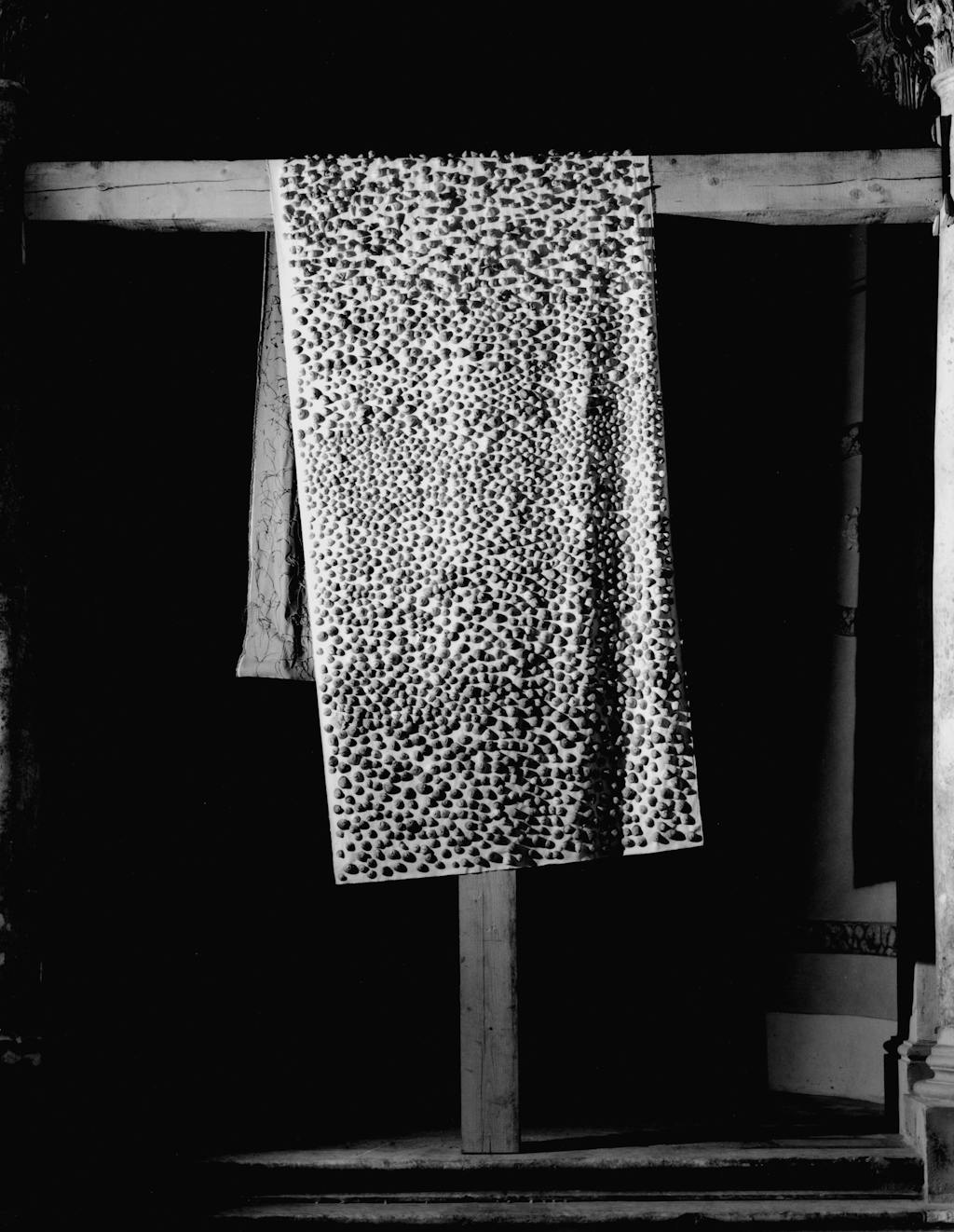Kounellis’ canvases from the late 1950s to the early 1960s are anchored in reality through the use of words in compositions that appropriate the techniques of urban signage, a visual language that is distinctly his. In 1958, he begins to paint shop signs spotted on the city streets, e.g. ‘Trattoria’ or ‘Aceto Olio’, in paintings that offer a simple recording of place and time. Then he combines letters and figures, using the same language familiar from marquee signs, but this time creating his own vocabulary in compositions populated by crosses and arrows that evoke an abstract score. Read aloud during performances, these paintings turn into corporeal experiences that mark the passage of time – the process of making the work as well as the performative approach.
The wide array of objects used by Kounellis reveals his fluid and changing approach to art in constantly renewed experiments. In 1964, he introduces a musical score in his painting; in 1967, live singing birds and the element of fire. The latter is central to the artist’s interests: it has the power to transform materials, symbolising change and the social upheavals of the time. It is the energy of a radically new art, which is both aggressive in the rethinking of its own paradigm and fragile in the consciousness of its limitations. Coal, the energy source that fueled the industrial revolution, becomes increasingly present in Kounellis’ creative language, as a possible element of change.
In the late 1960s, while conservative society sees its framework being torn apart, Kounellis, aware of the artist’s position as a public figure of change, transfigures the essence of painting. In 1969, at the Galleria l’Attico in Rome, he presents twelve live horses in the gallery space, infusing life into art on a pictorial plane that has expanded into a stage to propose a renewed paradigm – apprehending not only art, but also the role of the artist in a changing world. His aesthetics is almost hostile towards the viewer, who is brutally awaken by sensorial stimuli that are unusual in an artistic context: fear, heat, smell.
Smoke and soot appear in works from the 1970s and 1980s, which is reminiscent of the element of fire in earlier works as a memento mori of post-industrial times. They also stand for obscuring and the vulnerability of Kounellis’ singular position in contrast to spectacularistic and mercantilistic art production. From 1982 onwards, he focuses on his own artistic history following a process of accumulation and reuse of materials – often affixed to steel sheets the size of a double bed – as a way of regenerating his language by drawing from the past while asserting the foundations of his creative approach. From the early 1990s on, his works develop into large installations very much informed by tradition and sacredness that often confront the viewer’s spatial awareness.
Jannis Kounellis’ work was included in the seminal exhibition ‘When Attitudes Become Form’ curated by Harald Szeemann at Kunsthalle Bern in 1969, as well as in several iterations of Documenta and the Venice Biennale. A retrospective was curated by Germano Celant at the Fondazione Prada in Venice in 2019. Solo exhibitions have been held in numerous institutions, including Kunstmuseum, Lucerne (1977); Musée d’Art Moderne de la Ville de Paris (1980); Whitechapel Art Gallery, London (1981); Städtische Galerie im Lenbachhaus, Munich (1985); Institute of Contemporary Art, Nagoya (1985); Castello di Rivoli, Turin (1988); Stedelijk Museum, Amsterdam (1990); Kestner-Gesellschaft, Hannover (1991); Museo Nacional Centro de Arte Reina Sofía, Madrid (1996); Albertina, Vienna (2005); Kunstmuseum Liechtenstein, Vaduz (2006); Museo d’Arte Contemporanea Donnaregina, Naples (2006); Neue Nationalgalerie, Berlin (2007), amongst others. His works belong to major public collections, such as Kunstmuseum Bonn; K21 Kunstsammlung Nordrhein-Westfalen, Düsseldorf; MoMA – Museum of Modern Art, New York; Centre Pompidou, Paris; and the Tate, London.
